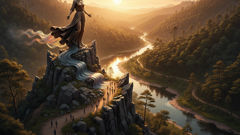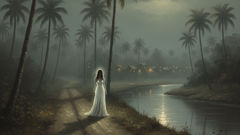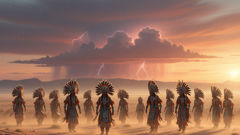Introduction
There are nights in Iceland when the world seems to hold its breath: the clouds lay low across glaciers, rivers freeze into glass, and the northern lights stitch color into a sky the color of bone. On such nights the old stories come alive in the corners of farmhouses and the low glow of peat fires. Foremost among those stories is the one about the Gryla, an ogress whose name was spoken in hushes by parents who wanted their children safe and obedient through the long, dangerous months of winter. The Gryla is not only a creature of fright; she is a figure braided into the land itself, a woman of volcanic shadows and fjord-ice, born from the geology and hunger of a harsh country where isolation breeds legends. This tale follows her from a time before memory, when the first settlements crept along coasts under cold stars, through the centuries she spent at the edges of hearthlight, to the present where artists, storytellers, and children keep retelling and reshaping her. Along the way you will meet her ragged sons — the Yule Lads — and witness how a story meant to warn and govern behavior grew into a cultural emblem, dark and oddly tender, that binds a people to their winter rituals. Listen for the creak of the door. Hear the wind over the ridge. The Gryla moves silently in those sounds, a reminder that myth is not merely a tale told for fright: it is a map for living in a world that can be cold and unforgiving.
Origins in Stone and Snow: The Birth of the Gryla
When you try to trace where the Gryla came from, the trail runs through geology as much as genealogy. In old Icelandic sagas and the loose oral traditions that braided them together, great events and great fears alike were placed in the landscape: a glacier that moved a man's house, an erupting volcano that swallowed entire valleys, storms that unmade a summer in a single night. For people whose lives leaned on the whims of ice and fire, stories served as both explanation and instruction. Gryla belongs to that lineage: she is less the invention of a single storyteller than the personification of the hunger and danger woven into Icelandic winter.
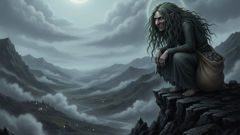
To describe Gryla is to choose between competing tales, each with a different emphasis. In some versions she is an enormous, hulking woman with horns like broken basalt, a face weathered and scarred by wind and ash. In others she is more human, albeit feral, a woman who walks hunched beneath a heavy fur cloak, carrying a sack that rattles with small bones. Most accounts agree that she was once a lonely figure who lived in the mountains or deep in lava caverns, exiled from villages because of her inscrutable ways. The poor and displaced often became the seedbeds of monstrous reputations. When food ran out, or when a child went missing, it was easier to point to a creature at the margins than to admit misfortune or the failures of a harsh economy.
The medieval context of Iceland — isolated farms, long winters, patchwork communities connected by travel that was arduous at best — shaped how the Gryla was used in speech and in custom. A child who wandered away from the farmhouse, who disobeyed warnings to be home by dusk, might be told that Gryla would take them. The threat was practical: in an environment where blizzards could come without warning, the most immediate danger was exposure. But the Gryla legend added moral dimension: children were urged to cooperate with family and neighbors, to conserve resources, and to respect rules that in a different era were rules of survival.
The Gryla also acquired a role as mother — terrifying and grotesque — and through that motherhood the story connected to Yule, the liminal season between darkness and the promise of returning light. The first references hint at a matron whose appetite was not satisfied by livestock or solitude. She sought the most tender food: children who misbehaved. For earliest storytellers, that image functioned as grim leverage. Parents would brandish the warning the way they brandished a rod; it was an oral contract: behave now, or you will be taken later. But tales of monsters often carry additional layers: they encode community anxieties, they allow catharsis for grief, and they are repositories for the collective memory of hunger. A famine in the highlands could be turned into a story about a creature who ate children; the act of naming turned random cruelty into something intelligible.
Beyond the moral, the Gryla is intimately linked to the Yule Lads. According to popular versions, the Gryla had many sons, grotesque and mischievous, each with a particular habit and a particular name. They visit households during the days before Yule, leaving gifts for good children and playing tricks on the others. Their list — Spoon-Licker, Door-Slammer, Sausage-Swiper — reads like household humor and cautionary tale at once. In several retellings the Yule Lads are both agents of their mother's appetite and independent mischief-makers, a complicated brood who reflect how behavior and consequence worked in the household economy: greed begets loss; mischief leads to admonition.
It is worth pausing on the interplay between terror and tenderness in these myths. Gryla was horrifying because she consumed children; she was a monster not only of body but of appetite. Yet as a mother figure she also clarifies certain cultural values: collective responsibility, the centrality of the hearth, and the idea that a community must educate its young through caution and ritual. The Gryla story became ritualized: at Yule, when the year closed on its darkest nights, the community would re-enact boundaries. The Yule Lads, paradoxically, softened Gryla's edges in the cultural imagination. Where she remained a warning, her sons became carriers of small joys and petty punishments — a narrative alchemy that turned unmitigated horror into a complex seasonal drama.
Throughout centuries, as climates shifted and settlements changed, the Gryla legend adapted. In coastal fishing villages, she might be blamed for boats that never returned; in mountain farms, for sheep gone at night. The core remained: Gryla is the embodiment of a wild, ravenous force that returns each winter, a reminder that human life in the north depends upon cooperation and attentiveness. And so she remains, in sagas and children's rhymes and in the names of cliffs and hollows where older people say you can still hear her approaching when the wind moves just so.
Survival, Storytelling, and the Yule Lads: How the Gryla Became Tradition
If the Gryla's earliest function was practical — a cautionary specter designed to keep children safe — her cultural afterlife has been broader and stranger. Over centuries the tale migrated into hearts and hearths, adapting as communities found new reasons to keep telling it. Here the Yule Lads play a crucial part: they are not merely her offspring but narrative instruments that allowed the tale to shift from terror to something more varied: mischief, reward, and ambivalent affection.
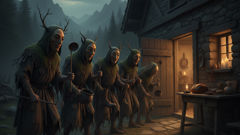
Consider the pattern of Yule visits: in many versions the lads come on successive nights leading up to Christmas, each with a distinct personality and each engaging in a particular domestic prank. Some names are comic — Spoon-Licker (Strýjabót), or Door-Slammer — and some are needle-sharp in their implied morality — Sausage-Snatcher or Bowl-Biter. For children these characters offered a dozen small lessons: mind where you put food, keep your door closed at night, don't take what isn't yours. Yet even as the lads carried warnings, they softened them with the prospect of gifts and the possibility of redemption. Good children found treats in their shoes; naughty ones found nothing but a sharpened reminder of their faults. The Yule Lads thus turned the Gryla's grim appetite into a social mechanism: infractions had consequences, but there was also a structure for forgiveness and correction.
The interplay of punishment and reward resembles many agrarian customs where seasonal cycles required both discipline and celebration. In small communities where resources were scarce and everyone depended on one another's prudence, folklore functioned as informal governance. Stories were easier to enforce than laws; repetition turned cultural norms into instinct. Parents didn't merely threaten to frighten; they taught with the vividness of narrative. The Gryla story, especially when paired with the antics of her sons, became pedagogy by picture: a child could understand the cost of misbehavior the way they could understand the taste of spoiled porridge — immediately and viscerally.
Beyond teaching, the figure of Gryla and her children became a resource for lament and resistance. During times of hardship, the tale allowed communities to name their losses in a shape that could be shared: 'Gryla took him' could mean more than a supernatural abduction; it could signal the tragic realities of famine or disease without laying blame publicly. In small, tightly knit communities such phrasing protected social cohesion. Conversely, as Icelandic society modernized and people moved into towns, the story morphed yet again. The Gryla received new layers: artists painted her with sympathetic hues, children’s books rendered her grotesque but comic, and tourists encountered her as a cultural icon in museums and gift shops. The tale's elasticity is its survival mechanic: it can terrify a child and then, a generation later, lend itself to festive merchandising.
Modern reinterpretations often emphasize context. Contemporary Icelandic authors and performers have written plays and poems that wrestle with Gryla as an allegory for hunger, for single motherhood, for the bulk of grief that comes with living in a place where nature is always the more powerful party. Some storytellers invert the tale, imagining Gryla as a wronged woman rather than a simple monster — a figure expelled by community norms, who turns predator because there were no alternatives. Other retellings complicate the Yule Lads, granting them personality and emotional agency beyond their names. These modern framings don't erase the old fright; they add nuance, a humanity that makes the myth productive beyond caution.
At the same time, the Gryla legend still performs its old social work. In January, when house parties and communal gatherings take place after the solstice, families tell old stories or sing songs whose lines echo the names of the Yule Lads. Traditional decorations once served as physical tokens of those lessons: small gifts placed in shoes, turned from a punitive instrument into an act of reciprocal care. Schools incorporate myth retellings to teach children about their heritage; films reframe the ogress in CGI while preserving the essential message about winter, vulnerability, and community.
Tourism has inevitably transformed the Gryla into an export. Visitors hungry for atmospheric myth come to Iceland to see the landscapes that birthed such stories and to learn the tales at visitor centers and winter festivals. That has its own consequences: commodification flattens details, and postcards give the point of a story to a caption. But even commodified, the legend serves as an entry point. A tourist who returns home and tells the tale of Gryla sends the myth further out into the world, where it finds new interpreters. The ogress thus migrates, not as a single fixed image, but as a set of motifs that repeat in other cultures' monsters: the wild mother, the punishment that preserves order, the liminal season when boundaries between worlds blur.
Finally, we come to the moral elasticity that keeps the Gryla alive: stories change to meet the needs of their tellers. When parents needed a stick with which to steer children from danger, a monstrous mother sufficed. When artists needed a symbol of environmental severity, they found her among lava fields and frozen fjords. When communities needed to hold grief without dissolving into accusation, her name became shorthand for unavoidable loss. In every case, the Gryla's core remains: she stands at the edge, where human order collides with the wild, and she insists that we remember our limitations. The Yule Lads teach that mischief and generosity are two sides of the same coin, and that one's place in a community depends on small acts repeated over time. That is the reason the tale is still told beside peat fires and in heated classrooms: it is a story about living together in a place that demands respect.
Conclusion
The Gryla endures because she is flexible as well as fearsome. As Iceland changed, the story of the ogress shifted from blunt instrument of discipline to a complex cultural emblem that can frighten, teach, and console. She remains an image for hunger and hardship and a dark mirror that helps communities to measure kindness against need. Whether told over a peat fire in a remote farmhouse or framed in a museum exhibit in Reykjavík, the tale insists on attention: to children, to neighbors, and to the seasons that shape human fate. In the modern telling there is room for compassion as well as caution. The Yule Lads, once the offspring of an almost elemental appetite, have become harbingers of both mischief and small mercies. The Gryla, monstrous and maternal, still prowls the margins of story — a reminder that myths survive because they can teach us how to live in the cold, and how to transform fear into ritual, warning into belonging. When the long winter winds set the curtains trembling and the aurora rides across the sky, maybe the old warnings still matter, and maybe telling the tale is its own small protection against the dark.








